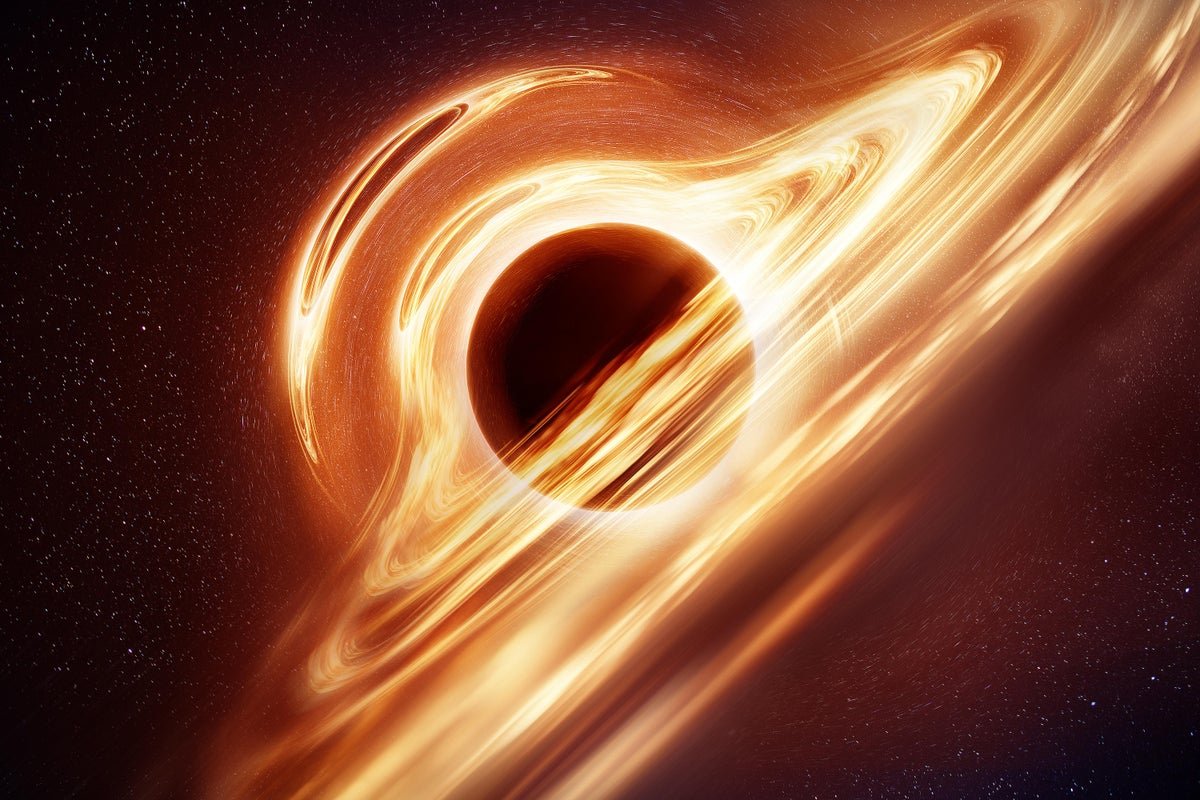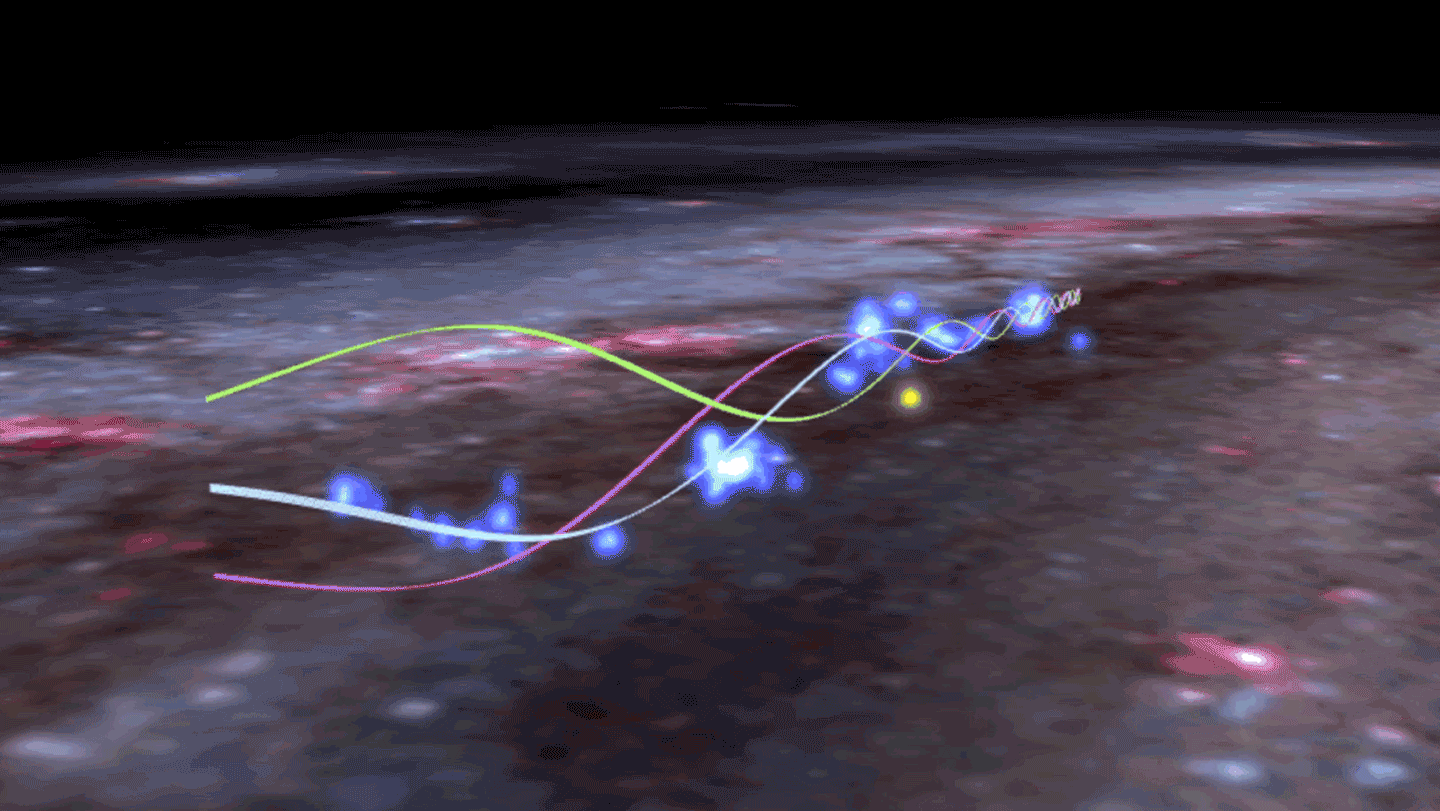Since its launch in late 2021, the James Webb Space Telescope (JWST) has been glimpsing some of the earliest epochs of cosmic time. Its observations have stretched cosmologists’ timelines of when galaxies may have first started to form. And now some of the telescope’s farthest observations yet have revealed sources of blue ultraviolet light from an epoch when stars shouldn’t have existed yet.
The observations indicate nine new light sources, with six at redshift 17 and three at redshift 25, when the universe was only 200 million to 100 million years old. “It’s the deepest by a factor of a few compared to any other data obtained by JWST in the whole mission,” says Pablo G. Pérez-González, an astrophysicist at the Center for Astrobiology in Madrid. He is lead author of a preprint paper reporting the findings that has been accepted for publication in the Astrophysical Journal.
“If we confirm that they are truly at those redshifts, the universe was much, much more active its first 200 million years” than astronomers had thought, Pérez-González says.
On supporting science journalism
If you’re enjoying this article, consider supporting our award-winning journalism by subscribing. By purchasing a subscription you are helping to ensure the future of impactful stories about the discoveries and ideas shaping our world today.
If accurate, the newly sighted objects don’t merely expand the timeline of galaxy formation back to a much earlier period; they sit in direct conflict with astronomers’ best cosmological models of when stars began to form during the cosmic dawn. For this reason, another group of astronomers have put forward a hypothesis to make sense of these puzzling findings. They have proposed that “primordial” black holes created right after the big bang may have lit up the universe before the first stars. Their preprint paper has been accepted for publication in the journal Astronomy & Astrophysics.
“If stars cannot explain the source of the luminosity and the numbers that we see, something else should be producing the light,” says Andrea Ferrara, an astrophysicist at the Superior Normal School (SNS) in Pisa, Italy, and co-author of the first paper. “This can only be a primordial black hole.”
In other words, it’s possible that the first objects to bathe the early universe in light were not stars but rather hungry black holes that burst into existence mere seconds after the big bang itself.
The Trouble with Early Galaxies
The farther we peer out to our cosmic horizons, the further back in time we see. And because the universe itself is expanding, light traveling from extremely distant sources has stretched its wavelength all the way to the infrared part of the electromagnetic spectrum. This phenomenon is what astrophysicists refer to as redshift. The higher the redshift of a distant object is, therefore, the further back in time you are looking.
Before JWST, the highest confirmed redshifted galaxy astronomers had observed was at redshift 9, when the universe was 600 million to 500 million years old. For the first couple of years after its launch, JWST spent a significant amount of its time confirming previously identified galaxies that had been observed by the Hubble Space Telescope (HST).
Variables such as the concentration of dark matter—an invisible gravitational source that outweighs visible matter in the universe by six to one—and the necessary conditions needed for star formation provide cosmologists with constraints to determine a rough timeline for the evolution of galaxies in the early universe. But after the summer of 2022, as JWST began revealing galactic candidates at earlier epochs, astronomers started to realize something wasn’t quite making sense.
“JWST is finding too many too massive galaxies too early in the universe,” says astrophysicist Allison Kirkpatrick of the University of Kansas, who specializes in galaxy evolution and was not involved in the new studies.
To date, the oldest confirmed galaxies observed by JWST are at redshift 14, when the universe was only 300 million years old. “So the idea here was to go beyond that, to redshift 15 and beyond,” Pérez-González says, “in search of the very first galaxies ever formed.”
His team’s report of nine new objects at even higher redshifts will need confirmation. To determine whether the objects are as far as they seem to be, astronomers must break up their light into specific wavelengths in a process called spectroscopy.
Drawing on data collected by JWST’s Near Infrared Camera (NIRCam) over two imaging surveys, Pérez-González and his team identified the new candidate galaxies from a pool of more than 80,000. After imaging a region of the sky with different filters for more than 100 hours, the astronomers were able to identify galaxies at different brightnesses and select the most promising candidates for further observation. Casting a wide net means their sample is less likely to be biased before they zoom in on the most interesting distant objects.
The suspected galaxies Pérez-González and his team found shine with bright blue light in the ultraviolet range of the spectrum—exactly the light astronomers believe the massive first stars would have produced. The problem with this scenario, however, is that galaxy evolution models have an extremely tough time producing stars at such early stages of the universe’s development. It’s doubtful that this time frame would have allowed enough time for gas to cool and gather into clouds large enough to gravitationally collapse into the first generation of stars.
“Galaxies cannot form quickly because the gas in the early universe is very hot, preventing it from collapsing into galaxies and stars,” Kirkpatrick says. “Instead dark matter structure grows first, and the immense gravity funnels gas to the center to grow the first stars and galaxies. This all takes time, more time than 100 million years.”
Black Holes from the Very Beginning
To get around this problem, Ferrara and his collaborators propose that primordial black holes—a distinct population of black holes that may have emerged in the first few seconds after the big bang—were consuming gas in the early universe. This feeding frenzy could have released light that we are now detecting with JWST at periods before the first stars formed. Bizarrely, black holes, not stars, might have been the first significant sources of light in the early universe.
Typically, black holes form when massive stars collapse after they run out of fuel or when a large cloud of gas directly collapses in on itself, bypassing the stellar phase. Primordial black holes, however, are different. “What we are proposing is that primordial black holes formed less than one second to five seconds after the big bang,” Ferrara says. “These have been essentially there forever, from the beginning.”
Initially, these black holes would have started out small, “no larger than the size of an atom,” Kirkpatrick says. Scientists think that within the first second of the universe as we know it bursting into existence, a rapid period of expansion, known as inflation, caused space to increase in size by 35 orders of magnitude, equivalent to an atom stretching to the size of the solar system. “This has a lot of consequences, including the creation of very small black holes,” Kirkpatrick says. Although starting out tiny, after 100 million years, these black holes may have swelled to 10,000 times the mass of the sun, Ferrara and his team suspect.
When gas gets near a black hole, it gets heated to scorching temperatures, and this superheated matter emits light. From a distance, it might look similar to the atmosphere of a star. For this reason, the difference between the primordial black hole explanation and the stellar explanation, based on the current imaging data, is nearly impossible to disentangle. But there may be other clues.
One way to distinguish if these light sources are primordial black holes or first-generation stars would be to look at the sizes of galaxies. If they appear more pointlike, then the primordial black hole explanation would make more sense because a massive black hole is still tiny compared with a whole galaxy. But if the light sources are diffuse and extended, then they might be more likely to be stars.
“So we measured the sizes, and some of the candidates are, to the best of our knowledge with the data that we have, pointlike but not all of them. Some of them are extended. So maybe 30 percent of them are consistent with what a primordial black hole might look like,” Pérez-González says.
Right now the data are hardly definitive. Because primordial black holes have hypothetically been around since the very beginning of the universe, they should also leave traces in the cosmic microwave background (CMB), a snapshot of the universe as it existed 380,000 years after the big bang. “Our pictures of the CMB maps are still a little bit too blurred in order to see the fine-structure details that primordial black holes may have introduced,” Ferrara says.
For now, a definitive answer is just beyond reach. The possible presence of primordial black holes may, however, make sense of another cosmological conundrum: the existence of supermassive black holes at the centers of galaxies at early epochs. “We haven’t yet proved how the first supermassive black hole seeds form, and this could be one pathway. It would help resolve some of the tension with JWST observations and cosmological models,” Kirkpatrick says.
“These observations are difficult, and we are pushing the JWST to its limit,” Ferrara says. “We have to be careful because maybe these galaxies could turn out to be contaminants or lower-redshift galaxies or something else.” But whether these mysterious black beacons outshone the first stars is a question we may soon have an answer to.




